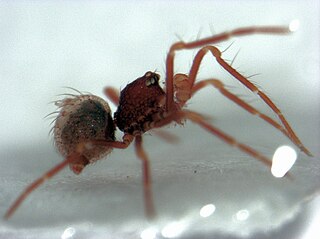
The spider family Liphistiidae was first recognized by Tamerlan Thorell in 1869. When narrowly circumscribed, it comprises a single genus Liphistius, native to Southeast Asia; as of April 2024, this was the circumscription accepted by the World Spider Catalog. The family contains the most basal living spiders, belonging to the suborder Mesothelae. The family has also been circumscribed more broadly to include the family Heptathelidae as a subfamily, Heptathelinae, with the narrowly circumscribed Liphistiidae becoming the subfamily Liphistiinae.

Anapidae is a family of rather small spiders with 232 described extant species in 58 genera. It includes the former family Micropholcommatidae as the subfamily Micropholcommatinae, and the former family Holarchaeidae. Most species are less than 2 millimetres (0.079 in) long.

The Micropholcommatinae are a subfamily of araneomorph spiders in the family Anapidae. They were previously treated as the family Micropholcommatidae. Micropholcommatins are extremely small, with body lengths typically between 0.5 and 2 mm. They are usually found among leaf litter or moss.
Mysmenopsis is a kleptoparasitic genus of tiny tropical and subtropical American spiders in the family Mysmenidae. Most live in the funnelwebs of spiders in the family Dipluridae. M. archeri lives on webs of a species in the family Pholcidae, M. capac and M. cienaga have been observed living in Cyrtophora (Araneidae) webs. One reason why diplurid webs are preferred seems to be that they are persistent in time and space, sometimes spanning several years.
This glossary describes the terms used in formal descriptions of spiders; where applicable these terms are used in describing other arachnids.

Coddingtonia is a genus of Asian ray spiders that was first described by J. A. Miller, C. E. Griswold, & C. M. Yin in 2009. It is a senior synonym of Luangnam.

Progradungula otwayensis, commonly known as the Otway odd-clawed spider, is a species of cribellate spider endemic to the Great Otway National Park of Victoria, Australia. It is one of only three species in the gradungulid genus Progradungula.
Pinkfloydia is a genus of small Australian long-jawed orb-weavers, reaching a maximum lengths of about 4.5 millimetres (0.18 in). It was first described by D. Dimitrov & G. Hormiga in 2011, and contains two species, found in New South Wales and Western Australia: P. harveyi and P. rixi. They have a unique rounded, cone-shaped head structure with one pair of large eyes and three pairs of smaller eyes. The genus is named after British rock band Pink Floyd.

Apneumonella is a genus of long-legged cave spiders that was first described by L. Fage in 1921. It is one of several genera, including Telema, Usofila, and Cangoderces, whose relationship within the family and to these other genera is still poorly understood.
Brasilionata is a genus of Brazilian spiders first described by Wunderlich in 1995. It is represented by a single species, B. arborense. The defining characteristics of this genus include a homogeneous color pattern on the back of the abdomen, setae on the cymbial fold the same size as other setae, a space between the anterior median eyes, and a pointed switch on the end of the palpal bulb similar to that of Microdipoena. Only two specimens have been identified, one in 1995 and another in 2015.

Afraflacilla roberti is a species of jumping spider in the genus Afraflacilla that is found in Kenya. The spider was first defined in 2011 by Wanda Wesołowska. She originally placed the species in the genus Pseudicius, but Jerzy Prószyński moved it in 2017 to Afraflacilla on the basis of shape of its copulatory organs. The species is named after Robert Jackson, the collector who found the first example. The spider is small, with a cephalothorax between 1.7 and 1.6 mm long and an abdomen between 1.7 and 2.4 mm long. The female is larger than the male. The carapace is a dark brown elongated oval with a black eye field covered in white hairs. The abdomen is blackish-brown and is marked by two pairs of white patches and a small number of faint chevrons at the very rear. Some female examples have a generally featureless dark abdomen and others have additional small rounded patches at the edge. Some have light stripes to the front of the abdomen. The spider has yellow legs, apart from the front pair, which are brown, longer and stouter. It stridulates using its legs and carapace. Afraflacilla roberti can be differentiated from other species in the genus by its copulatory organs. The male has a long thin tibial apophysis. The female has narrow coiled insemination ducts.

Pseudomogrus improcerus is a species of jumping spider in the genus Pseudomogrus that is endemic to Yemen. The species was first defined by Wanda Wesołowska and Antonius van Harten in 1994. They originally placed it in the genus Yllenus, but was moved to the new genus Logunyllus in 2016, and then to its present designation in 2019. The spider is small, with a carapace measuring between 1.84 and 1.9 mm long and an abdomen between 2.05 and 2.1 mm long. The female has a red-brown or brown carapace and brownish-grey abdomen covered in small brown, grey, white and golden scales. Some examples have a band across the top of the abdomen. The spider has yellow legs. The copulatory organs are distinctive and enable the spider to be distinguished from others in the genus. The female epigyne has simple insemination ducts and large accessory glands.
Urogelides is a genus of jumping spiders containing one described species, Urogelides daviesae, and other undescribed species. It was first described by Marek Michał Żabka in 2009, and is found in Queensland, Australia.
Epeirotypus is a genus of ray spiders that was first described by Octavius Pickard-Cambridge in 1894.
Tanzania mkomaziensis is a species of jumping spider in the genus Tanzania that lives in Ethiopia, Ivory Coast, Nigeria, South Africa and Tanzania. First described in 2000 by Wanda Wesołowska and Anthony Russell-Smith, it is a very small spider with a carapace between 0.7 and 1.1 mm long and an abdomen between 0.8 and 1.4 mm long. The male spider's carapace is generally yellowish-orange while the female is brown. All have a darker eye field. The spider's abdomen varies, with some being a plain dark grey, greyish or olive-grey and others, particularly those found in Ethiopia, having a dark mosaic pattern. The spider's legs are often black, but some specimen have paler legs and others have yellow legs with black rings. Its pedipalps are yellow and its spinnerets are grey. The spider has distinctive copulatory organs, particularly the short coiled embolus on the male and the sclerotized fringes on the female epigyne.
Ragatinus maddisoni is the type species for the genus Ragatinus. It is a species of jumping spider that is endemic in Kenya, living in forested afromontane regions. First described in 2016 by Angelika Dawidowicz and Wanda Wesołowska, it is named after the arachnologist Wayne Maddison. The spider is medium-sized and generally light brown, with a cephalothorax that is between 2.0 and 3.0 mm long and an abdomen between 2.2 and 4.0 mm long. It has light brown legs, the foremost ones being longer and darker. The species is most easily distinguished from other spiders by its copulatory organs. The female has a triangular depression in the middle of its epigyne and the male has a protuberance with teeth attached to the base of its curved embolus.

Langelurillus manifestus is a species of jumping spider in the genus Langelurillus that lives in Tanzania. It was first described in 2000 by Wanda Wesołowska and Anthony Russell-Smith. The spider is small, with a carapace that is between 2.1 and 2.5 mm long and an abdomen between 2.0 and 2.2 mm long. The female carapace is lighter than the male and has a pattern of irregular patches, which may also be found in some examples of the female abdomen. The male abdomen is lighter and has a fawn streak down the middle. The legs are brown, the female having dark rings on its legs. It is similar to other related species, particularly Langelurillus rufus, but can be distinguished by the male's larger size and lighter coloration. The female has an oval epigyne that leads to seminal ducts that are shorter than Langelurillus rufus but longer than Langelurillus squamiger.

Langelurillus primus is the type species for the genus Langelurillus. It is a jumping spider that is endemic in Kenya first described in 1994 by Maciej Próchniewicz, the species name denoting its position as first to be identified. The spider is small, with a orange-brown or dark brown carapace that is between 2.2 and 2.8 mm long and a dark yellow, greyish-brown or yellowish-green abdomen between 1.95 and 3.5 mm long. The female is longer than the male. The abdomen often has a pattern of spots. It has hairy legs. The male has three tibial apophyses, or spikes, a short pointed embolus and a large ovoid tegulum. The female has a very small epigyne that has a single pocket. The species can be distinguished from the related Langelurillus kenyaensis and Langelurillus krugeri by the design of the female copulatory organs, particularly the length of the seminal ducts.
Diphya wesolowskae is a species of long-jawed orb weaver in the genus Diphya that lives in South Africa. First described in 2020 by Mikhail Omelko, Yuri Marusik and Robin Lyle, the spider is small, with a typical length between 2.8 and 3.17 mm. The female is larger than the male. It has a brown to dark brown and patternless carapace, which distinguishes the species from the more common Diphya simoni. The male has an abdomen that is also brown to dark brown and has a pattern of two dark spots, although some examples have more complex, but indistinct, patterns of spots and stripes. The female has a light brown abdomen marked with large spots and stripes. The copulatory organs are distinctive to the species. The female has a epigyne that lacks pockets but has a thicker septal stem than Diphya foordi, and the male has a very long, thin projection that extends from the palpal bulb beyond the cymbium and a very short embolus.








